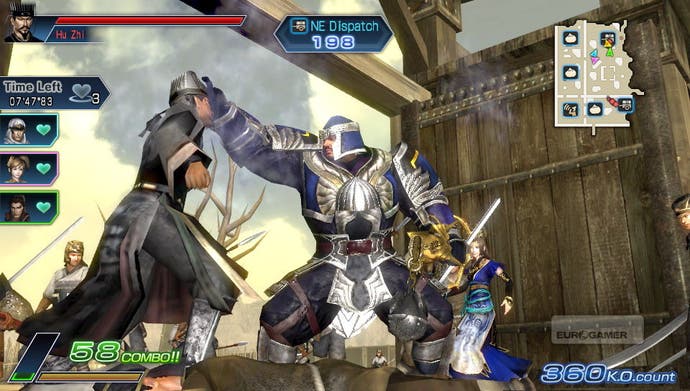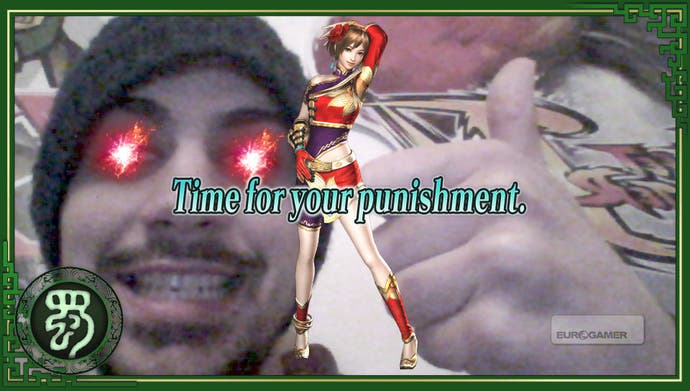Dynasty Warriors Next Review
Touchy subject.
Like death and taxes, the Dynasty Warriors series has become something of a fixed constant, appearing almost as regularly as a new toothbrush (for me at least) with its tried-and-tested mix of wandering hack-and-slash combat where you steamroller through a sea of similar-looking troops - to the point where developer Omega Force would have us believe that the Chinese perfected cloning well before Dolly the sheep. It's also journalistic custom to review a Warriors sequel with a precursory shrug and a level of "here we go again" acceptance, but in truth, Dynasty Warriors Next is a tangible departure from the Dynasty norm.
Making its Vita debut in timely fashion, Next pillages all 65 characters from Dynasty Warriors 7: Xtreme Legends while maintaining an equally robust graphics engine. Although the draw distance and volume of on-screen enemies are a fraction less extreme, in all other respects Next is an uncompromising match for its console brother. But far from being a straight-up Dynasty Warriors 7: Takeaway Edition with no distinguishing qualities besides portability, Next takes inspiration from the wider series while playing to the strengths of the new handheld.

That said, it wouldn't be Dynasty Warriors without Omega Force's unique interpretation of the Romance of the Three Kings narrative, and in this regard, the single-player Campaign Mode lives up to expectations by retelling the events of the warring Wei, Wu and Shu Dynasties with a handful of pre-rendered cut-scenes and a cast of one-dimensional characters. But while major events like the Yellow Turban Rebellion and the Battle of Red Cliffs will be instantly familiar to both Dynasty fans and well-read historians, the path to victory is as much about dominating the map as it is about hunting down enemy officers.
Borrowing from the Empires spin-off series, each battle begins with both sides occupying a Main Camp. By making your way to the enemy encampment and battering anything that moves till the defence counter reaches zero, you'll secure a win. The rest of the battlefield, meanwhile, is made up of lesser locations that offer additional benefits - ranging from Dispatch and Armoury bases that dish out items and troop enhancements to Lairs that bolster your ranks with war wolves, war tigers and war pandas. Although that's not to suggest that Dynasty Warriors is in any way responsible for the endangered species list.
The responsive combat system ditches the weapon-switching from Strikeforce and Dynasty Warriors 7 in favour of dedicated implements. This gives each fighter a more distinct personality, and when combined with the new Chain Attack system - which lets you cancel out of a Strong or Normal - it's clear that Next is less about bombarding you with weapon types and more about offering a narrow set of options that encourage creativity. And while tapping the square button a thousand times will guarantee your eventual victory on anything less than Hard, you now have to show the screen a similar level of love.

Of all the Vita games I've played, Next is the most doggedly determined to implement touch controls at every possible juncture - and although the shoehorning is a tad inelegant at times, on the whole, the game is the richer for it. By tapping either side of the touch-screen, your character will strike a snazzy pose before executing their Speed Musou. These deviate from standard Musou specials by being more about crowd control, with ground pounds that have you shaking the Vita to a Bemani-style beat, and vortexes that can be strengthened by twirling your finger.
Wandering around the battlefield also presents its own challenges, as you'll occasionally be ambushed by a Sudden Encounter. These are motion-based stand-offs that range from rapidly deflecting oncoming arrows to angling the Vita like a sniper scope to target an enemy's weak spot. But while these are all enjoyable additions that help break up the combine-harvester routine, the new officer Duels are comparatively dull. Essentially, they boil down to one-on-one touch-screen showdowns that activate whenever you near a strong opponent, but once you figure out the basic counter-attack pattern, the challenge factor evaporates almost entirely.
Thankfully, the four mini-games that appear in between the Campaign Mode missions (yes, there's even more!) are less of a drudge. The best of the bunch is Steeplechase, a point-to-point time trial that has you tilting the Vita to steer your horse around a track with jumps and obstacles. Undeniably basic, but its rare occurrence keeps things fresh. Calligrapher, meanwhile, is more redundant, as you have to fumble with the rear touch-pad to reveal a hidden Chinese character before tracing it on the touch-screen. It'd be churlish to call it edutainment, but, well, it kind of is.

Far less educational is the Gala Mode that features a Musou Snapshots editing suite which, while no more sophisticated than the Wii Photo Channel, does include some character art that you can arrange into all sorts of cut-and-paste scenarios. Once that's lost its novelty, you can build your own character in Edit Mode with all the customisation parts you've unlocked by winning battles. This isn't much more sophisticated than the equivalent Monster Hunter system, but with eye-patches, dreadlocks, mystic pants and cowboy shirts that lack the quintessential Clint Eastwood chic, there's still scope for creativity.
Your makeshift warrior can then make his or her debut in a Conquest Mode that, unlike the sprawling maps and "what if?" scenarios of Dynasty Warriors 7, is more akin to Empires. You can choose a skirmish that's anything between two forces fighting over eight territories to five forces vying for most of ancient China. This mode is designed to keep you occupied long after the main Campaign has finished, and with the ability to select a five-officer team irrespective of allegiance, its longevity will be determined by both your genocidal threshold and how long it takes Tecmo Koei to release the inevitable sequel.
You can also team up with three other players in Coalition Mode to play co-operative games like Sentinel and Sudden Death, with the latter being the Dynasty Warriors equivalent of one-shot one-kill. Unfortunately, this is only possible via local ad-hoc. But while Next lacks online multiplayer in the traditional sense, it does feature a passive Network system that populates Conquest Mode with the armies of other online players while sending out challenges automatically. If this turns out to be a Duel, you won't actually fight the opponent in real-time, but you will be informed of how your AI-controlled character performed.

Next comes across as a game that's embracing the Vita wholeheartedly on a surface level while being much more reserved in terms of Wi-Fi and 3G connectivity. This is a shame, as with a bit more imagination, it could have risen from being the best Dynasty Warriors game to grace a handheld to one of the most dynamic and comprehensive games on an emerging system. As it stands, Next is an attractive package that tries a lot of new ideas - most of which work - while tightening up the combat in a few key areas.
It even features a hint system which solemnly suggests that "over-thinking things only makes them more difficult. Approach matters simply and you will find the path you seek." Some would say this is the Omega Force approach to game design, but if ever there was a game that proved otherwise, it's Dynasty Warriors Next.

